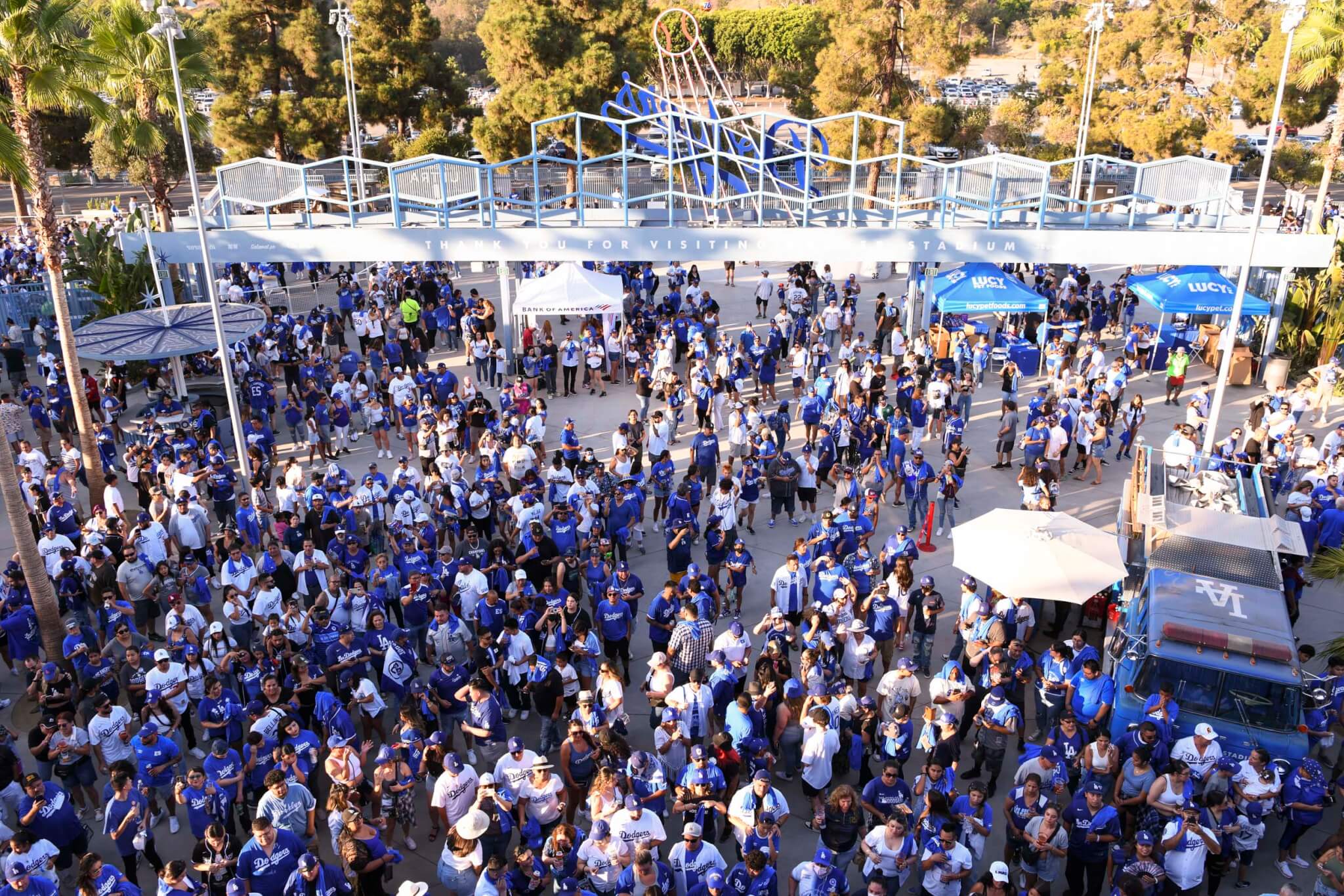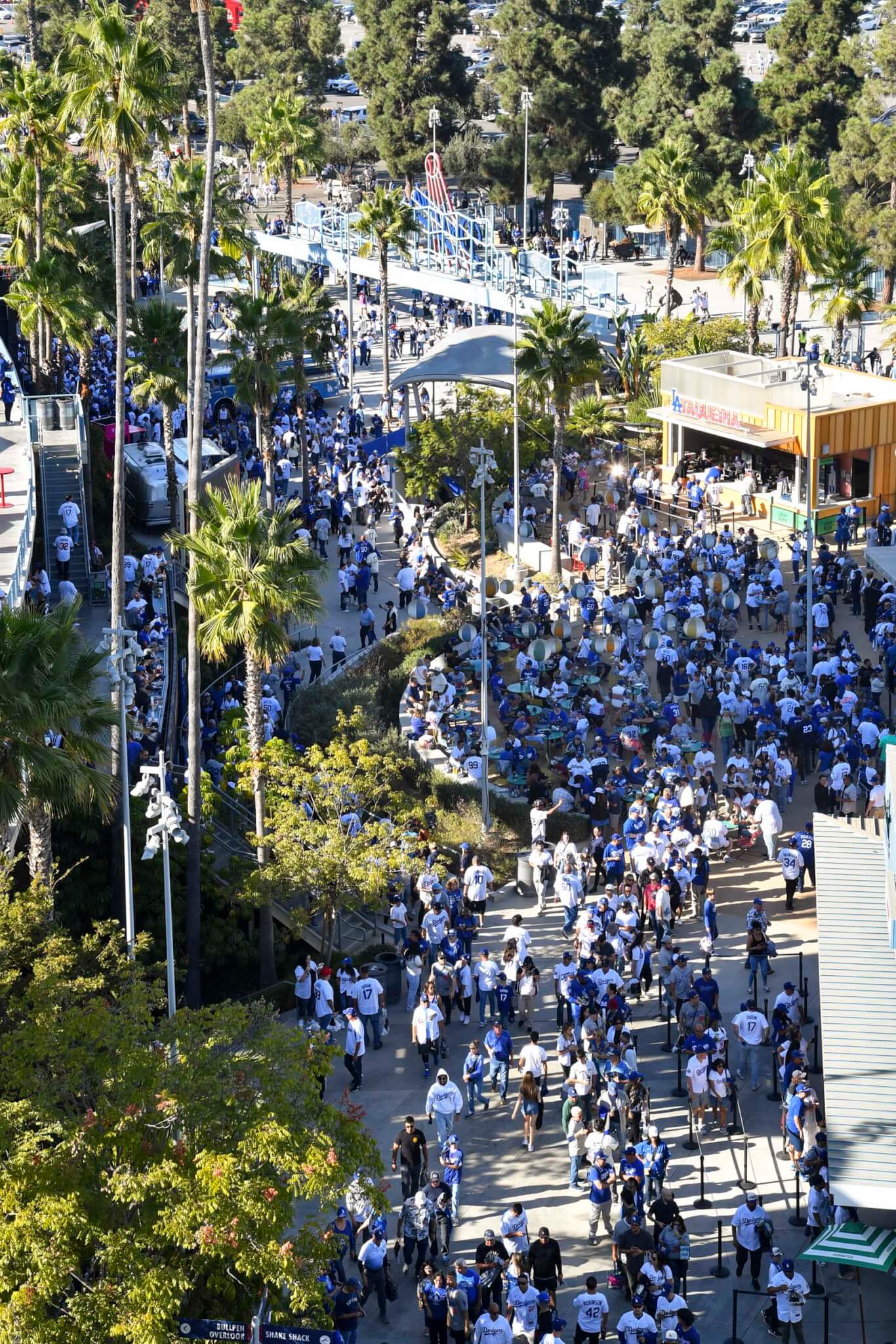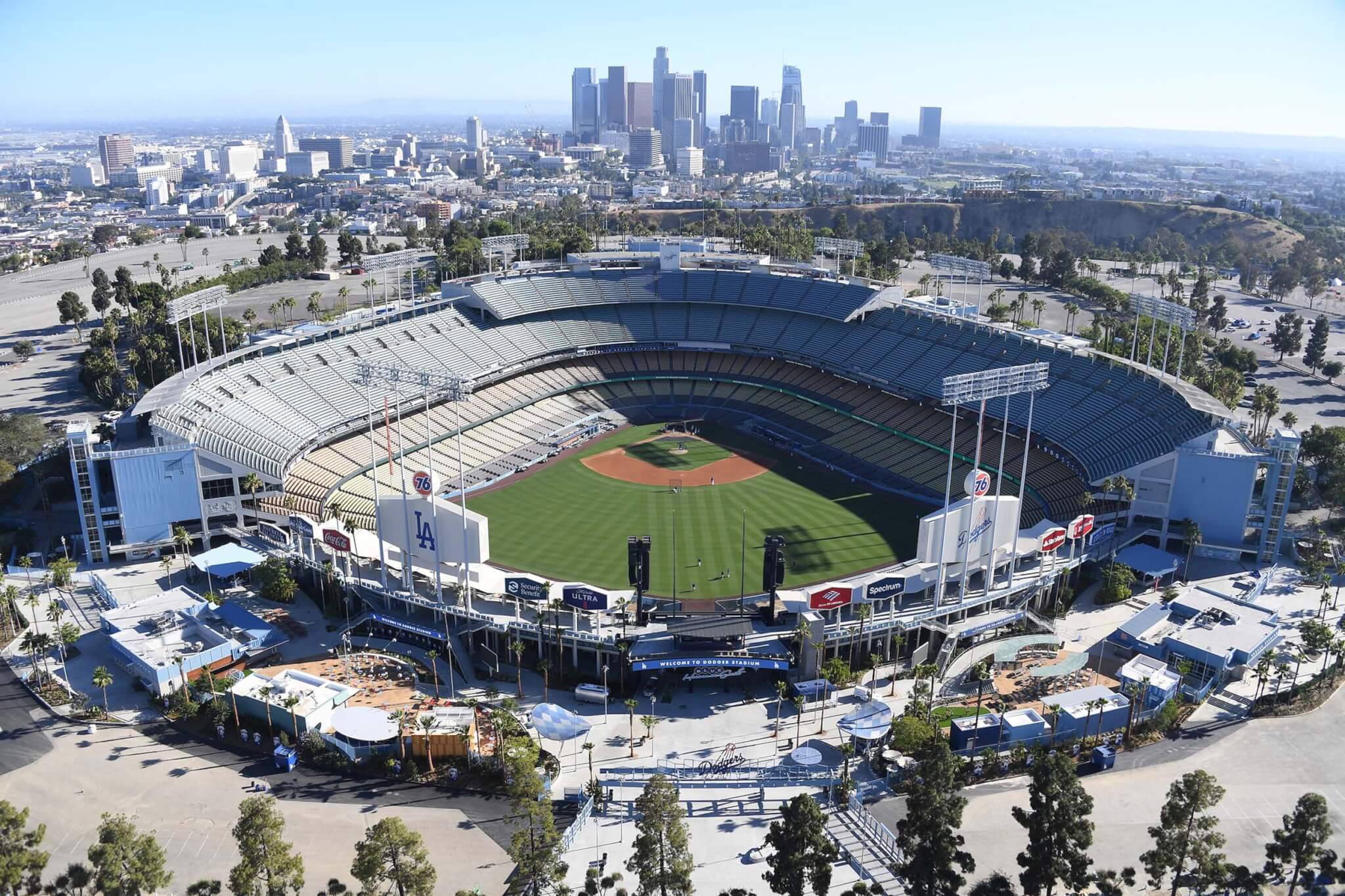Much of the talk going into this year’s Major League Baseball (MLB) season was about the Dodgers, winners of the 2024 World Series, somehow getting even better. In January, the team signed a sought-after free agent pitcher from Japan, Roki Sasaki, a move that is expected to make the champions even more formidable. The rest of the baseball world treated the event like an existential plague on the national pastime. As an ESPN headline complained, “Are the Dodgers ruining baseball?”
Meanwhile, Sasaki, Shohei Ohtani (another Japanese superstar, who is now a three-time MLB MVP), and their new teammates were about to get a first look at the updated clubhouse—the centerpiece of an estimated $100 million renovation—that the organization built in the offseason. Construction began literally the day after their championship parade in early November and continued right up to opening day in late March. The team’s approach to continually upgrading Dodger Stadium, which opened in 1962 with a midcentury modern design by Emil Praeger of Praeger-Kavanagh-Waterbury, Engineers-Architects, could inspire an entirely different question: Are the Dodgers saving baseball stadium architecture?
This latter inquiry is less hyperbolic than it may seem. Dodger Stadium is now the third oldest Major League Baseball stadium, behind only Boston’s Fenway Park (1912) and Chicago’s Wrigley Field (1914). As baseball has become a bigger and bigger business, the teams’ billionaire owners have tended to tear down older buildings to build more heavily amenitized offerings with luxury suites, retractable roofs, and state-of-the-art clubhouse facilities for the players and team personnel.
It would be easy to imagine the Dodgers joining the trend to jettison their current home for a flashier new model along the lines of BIG and HNTB’s design for Las Vegas’s new MLB stadium, the future base of the Athletics franchise, which has earned comparisons to the Sydney Opera House and which BIG’s Bjarke Ingels has dubbed a “spherical armadillo.” (Online observers noted its white-painted roof ought to be changed, as the color will make it hard for outfielders to track fly balls.) It is supposed to be ready for the 2028 season, when Dodger Stadium will turn 66.
Becoming a Midcentury Modern Classic
Architectural preservation is not something normally associated with professional sports, though in Fenway and Wrigley, baseball has two well-known examples.
(New York’s famed Yankee Stadium and Madison Square Garden are on their third iterations, including extensive renovations and complete rebuilds.) Dodger Stadium, with its hexagonal scoreboard, sunset-colored seating, and open views to the San Gabriel Mountains, seems to be joining these more centrally urban counterparts.
Janet Marie Smith, executive vice president, Planning & Development, for the team, argues that it is time for Dodger Stadium to earn proper recognition. “It’s interesting that if you look at books on architecture in Los Angeles through the 2000s, [they] don’t even give Dodger Stadium a mention,” Smith told AN.
Since earning a BArch and a master’s in Urban Planning, Smith has dedicated her career to designing baseball stadiums: As the Orioles’ vice president of Planning and Development, she drew on her training to deliver Camden Yards in Baltimore, which became the blueprint for the intimate, urbanized ballpark.

Smith has developed a theory about why the landmark in Chavez Ravine hasn’t earned the status of local art deco standouts such as Griffith Observatory or the Wiltern Theater or even Frank Gehry’s swooping Walt Disney Concert Hall. “Architects are such snobs,” she said, with a laugh. “Like, how could a stadium be important?”
She added that when she went to work for the Dodgers after Guggenheim Baseball Management purchased the team in 2012, she consulted what she called “that pink book,” Charles Moore’s 1984 classic The City Observed, about Los Angeles’s built environment, to see how he ranked her new home base. “It doesn’t even mention Dodger Stadium,” she noted.
By contrast, Pulitzer Prize–winning architecture critic Paul Goldberger, author of Ballpark: Baseball in the American City (2019), declared Dodger Stadium “wonderful” in a recent call with AN. “I think they’ve taken really good care of it and generally made it better, getting rid of a few things that didn’t fit that well and continuing to build off the strengths of it.”
Goldberger was referring to a flurry of activity that Smith undertook after joining the organization when veteran MLB executive Stan Kasten—with whom she worked transforming the 1996 Summer Olympics stadium into Turner Field for the Atlanta Braves—became CEO and convinced her to join the team.
Adapting Baseball’s Biggest Ballpark
With its capacity of 56,000, Dodger Stadium is an outlier in today’s baseball-as-entertainment landscape and an unusual deviation from typology both for its time and for the current day. In the 1960s, as professional football rose in popularity, stadiums were frequently built to accommodate both sports and their respective fan bases. This involved changing the configuration of the fields and in many cases creating less-than-ideal sightlines for some spectators. Walter O’Malley, the owner of the Brooklyn Dodgers who infamously moved the team west, insisted that Dodger Stadium be built exclusively for his team.
Goldberger said that this is a main differentiator today. “It was a baseball-only ballpark, built at a time when most others were baseball–football combinations, which were almost always terrible and almost always to the detriment of baseball.”
Over time, these hybrid stadiums became outdated, in part because they were too small for the National Football League games and too large for baseball fans, who began to prefer more intimate experiences. For instance, the New York Mets’ Shea Stadium and the Seattle Mariners’ Kingdome were both torn down in the 2000s and replaced with comparably cozier environs: Each new field reduced seating capacity by over 10,000.

The size of Dodger Stadium and its siting are two of the factors that appealed to Smith when she took the job, she said. For the first set of upgrades under her watch, Smith worked with DAIQ Architects, Levin & Associates, landscape architects Studio-MLA, and Hunt Construction Group (now AECOM Hunt) to improve the fan experience and to make upgrades that would impress the players. “We did something like 35 new restrooms, four new team stores, big new plazas, retail, and food and beverage from foul pole to foul pole, around home plate,” she recalled. The lineup worked, and Smith brought back most of the same team to execute the latest round of renovations (PCL Construction replaced Hunt in 2014).
When the 2021 season—which welcomed fans back after the 2020 season was played in empty stadiums due to COVID-19—began, Smith and her architectural and design team showed off the most significant glow-up: a $100 million project centered on a new center field plaza that included an entry point for fans and hospitality areas that leaned into the midcentury modern style. The architects also improved the circulation flow for fans entering and maneuvering around the stadium in search of restrooms and Dodger Dogs (which debuted the same year as the stadium). Smith said that the team hired AECOM to study the movements of fans from the parking lot through the entry and around the stadium, and its research informed the build-out of the plaza and led to other strategic changes.
Constructing a 21st Century Clubhouse
This past offseason, the extensive renovations involved excavation: The architects and engineers went underground to create a luxurious clubhouse experience for the home-team players. Officials, including Smith, are tight-lipped about the clubhouse upgrade, citing player privacy (hence why the team declined to offer interior photography for this article). In an interview with MLB radio, Kasten divulged that the clubhouse and common areas increased in size by 40 percent, adding an extra batting cage, meeting rooms, and chill-out spaces so that stars such as Mookie Betts could take naps. “We had to change the geography inside our clubhouse,” the CEO said.
Smith laughed about the evolution of the old-school idea of a locker room to today’s more thought-out clubhouses, adding that the new facility at Dodger Stadium was intentionally designed for what she called the “whole athlete.” “One of the things our chairman, Mark Walter, has said is that he wanted the players to feel that this was a place they could go year-round—that it wasn’t just a home during the season or a place to go pregame,” Smith said, mentioning Guggenheim’s CEO.

As for the new nap rooms and state-of-the-art batting cage outfitted with technology to help Ohtani and Betts maintain their Hall of Fame–worthy batting swings, Smith explained that the overhaul reflects a new approach to player development. She called the cage “sort of the heart of the clubhouse,” and noted that today’s generation of professional baseball players require places “for both physical and mental recovery.”
Here is where Dodger Stadium’s age worked against the team’s ambitions. Smith explained that the project resulted in the creation of a massive construction site—photos circulated online of the baseball diamond surrounded by cranes and mounds of dirt. “You might say, ‘Why did you need a landscape architect for the clubhouse?’” Smith said. “But whenever you do a project this large in Los Angeles, you must meet certain requirements for water retention and how you handle the LID [Low Impact Development] planters, for instance. And so, there are planters that have been added on the Dodger Stadium perimeter in a way that is very artful and yet meets the requirements.”
The tight timeline for the project resulted in at least one shortcut: While this year’s renovations added space for similar improvements to be made on the first base side of the stadium, which includes the visitors’ clubhouse, there are no plans yet for that project.
Building a Legacy on the Field and for the Stadium
Regardless of critical consensus about its architecture, baseball fans consider Dodger Stadium a temple. Sitting in the stands as twilight engulfs the mountains in the distance, creating a fiery glow, while watching a ballgame in the warm Southern California air is as revered an experience as peering out at Fenway’s Green Monster—the 37-foot-tall left field wall that is one of Boston’s great landmarks—or walking through Chicago’s vibrant urban neighborhoods to go root for the Cubs amid Wrigley’s famed ivy-covered outfield walls.
Today’s Dodger Stadium is a remarkable result for a complex built amid a bicoastal series of upheavals. The organization that became the Dodgers started playing in Brooklyn in the late 19th century, and O’Malley became an all-time villain in the borough when he uprooted the team to L.A. in time for the 1958 season. (They played at the L.A. Coliseum for those first few years.) O’Malley wasn’t exactly a darling in his adopted hometown at first; the team was awarded the site of Dodger Stadium by the city after nearly a decade of displacing Mexican American residents for an affordable housing development that was never built, leading to heated protests.

Goldberger noted that this era has yielded two recommended books about the circumstances around the building of Dodger Stadium: City of Dreams: Dodger Stadium and the Birth of Modern Los Angeles (2017) by Jerald Podair and Stealing Home: Los Angeles, the Dodgers, and the Lives Caught In Between (2021) by Eric Nusbaum.
“If nothing else, Dodger Stadium has inspired a lot of really interesting writing and research, because it is a fascinating story,” Goldberger said, adding, “Within it is almost every issue about the 20th century city.”
Goldberger alluded to the lack of public transit, which affects the experience of attending a Dodger game; it’s clearly something Smith has grappled with, given her previous roles creating and renovating stadiums in walkable urban environments. Smith is now part of a championship organization whose historic stadium will continue to change. Her team of architects, designers, and artists have contributed to the Dodgers’ winning culture, on the field and in the built environment that surrounds it.
→ Continue reading at The Architect's Newspaper
